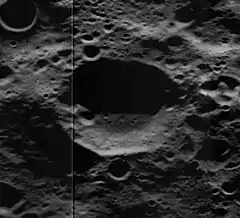 Clementine mosaic | |
| Coordinates | 38°30′N 124°42′E / 38.5°N 124.7°E |
|---|---|
| Diameter | 43 km |
| Depth | unknown |
| Colongitude | 235° at sunrise |
| Eponym | Nikola Tesla |

Oblique Lunar Orbiter 5 image, facing west

View from Apollo 13
Tesla is a lunar impact crater that is located on the Moon's far side, just to the southeast of the larger H. G. Wells. About one crater diameter to the southwest of Tesla is Kidinnu, and to the southeast is Van Maanen. The crater is named after Serbian-American inventor Nikola Tesla.
Tesla is a circular, bowl-shaped feature. There are a pair of small craterlets in the southern inner wall, but the crater is otherwise free of overlapping craters of significance. Only a few tiny impacts mark the floor and remaining sides.
Satellite craters
By convention these features are identified on lunar maps by placing the letter on the side of the crater midpoint that is closest to Tesla.
| Tesla | Latitude | Longitude | Diameter |
|---|---|---|---|
| J | 37.2° N | 126.7° E | 18 km |
See also
- 2244 Tesla, minor planet
References
- Andersson, L. E.; Whitaker, E. A. (1982). NASA Catalogue of Lunar Nomenclature. NASA RP-1097.
- Blue, Jennifer (July 25, 2007). "Gazetteer of Planetary Nomenclature". USGS. Retrieved 2007-08-05.
- Bussey, B.; Spudis, P. (2004). The Clementine Atlas of the Moon. New York: Cambridge University Press. ISBN 978-0-521-81528-4.
- Cocks, Elijah E.; Cocks, Josiah C. (1995). Who's Who on the Moon: A Biographical Dictionary of Lunar Nomenclature. Tudor Publishers. ISBN 978-0-936389-27-1.
- McDowell, Jonathan (July 15, 2007). "Lunar Nomenclature". Jonathan's Space Report. Retrieved 2007-10-24.
- Menzel, D. H.; Minnaert, M.; Levin, B.; Dollfus, A.; Bell, B. (1971). "Report on Lunar Nomenclature by the Working Group of Commission 17 of the IAU". Space Science Reviews. 12 (2): 136–186. Bibcode:1971SSRv...12..136M. doi:10.1007/BF00171763. S2CID 122125855.
- Moore, Patrick (2001). On the Moon. Sterling Publishing Co. ISBN 978-0-304-35469-6.
- Price, Fred W. (1988). The Moon Observer's Handbook. Cambridge University Press. ISBN 978-0-521-33500-3.
- Rükl, Antonín (1990). Atlas of the Moon. Kalmbach Books. ISBN 978-0-913135-17-4.
- Webb, Rev. T. W. (1962). Celestial Objects for Common Telescopes (6th revised ed.). Dover. ISBN 978-0-486-20917-3.
- Whitaker, Ewen A. (1999). Mapping and Naming the Moon. Cambridge University Press. ISBN 978-0-521-62248-6.
- Wlasuk, Peter T. (2000). Observing the Moon. Springer. ISBN 978-1-85233-193-1.
External links
This article is issued from Wikipedia. The text is licensed under Creative Commons - Attribution - Sharealike. Additional terms may apply for the media files.
